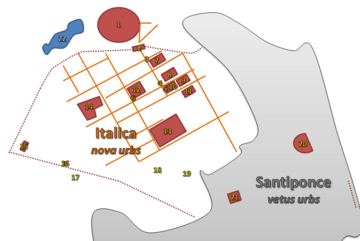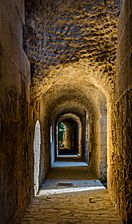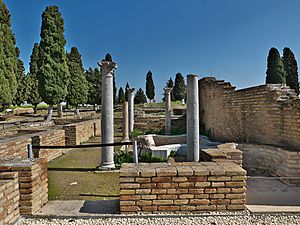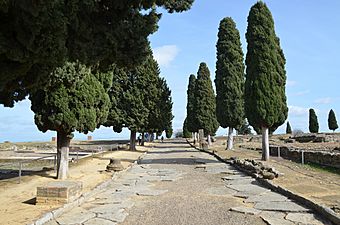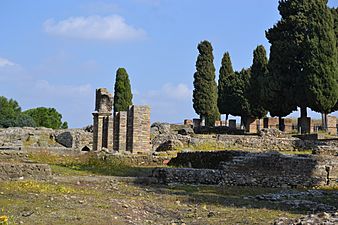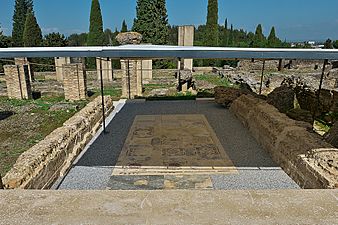Italica facts for kids
|
Itálica
|
|
| Location | Santiponce (Seville), Spain |
|---|---|
| Region | Hispania Baetica |
| Coordinates | 37°26′38″N 6°02′48″W / 37.44389°N 6.04667°W |
| Type | Settlement |
| History | |
| Founded | 206 BC |
| Cultures | Roman |
| Site notes | |
| Condition | Ruins |
| Type | Non-movable |
| Criteria | Archaeological site |
| Designated | 13 December 1912 |
| Reference no. | RI-55-0000002 |
Italica (Spanish: Itálica) was an ancient Roman city in what is now Spain. It is located near the town of Santiponce in the province of Seville. A famous Roman general named Scipio founded Italica in 206 BC. He created it as a special settlement for his soldiers who had fought bravely.
The city was named Italica because many of these soldiers came from Italy. Over time, more people from Italy moved there. Children of Roman soldiers and local women also helped the city grow. Two famous Roman emperors, Trajan and Hadrian, were born in Italica. Their families, the Ulpii and Aelii, were among the early settlers. Some people also believe that Emperor Theodosius I was born here.
Contents
History of Italica: From Founding to Decline
How Italica Was Founded by Roman Soldiers
Italica was the very first Roman settlement built in Spain. It was also the first Roman city created outside of Italy. General Publius Cornelius Scipio founded it in 206 BC. This happened during the Second Carthaginian War. He chose a spot near an older Iberian town. This town belonged to the Turdetani people.
Scipio created Italica for his veteran soldiers. Most of them were allies of Rome, but some were Roman citizens. He named the city Italica after their Italian origins. A nearby city called Hispalis (Seville) was larger. But Italica was important because of its special beginning. It was also close to the Guadalquivir River, which helped control the area.
Growth and Expansion Under Emperor Hadrian
The original part of Italica, called the vetus urbs (old city), became very successful. It was built with a clear street plan, like a grid. Public buildings and a central forum were at its heart. The city also had a busy river port. Italica especially thrived under Emperor Hadrian. He loved the city because it was his birthplace.
Hadrian expanded the city to the north. This new part was called the nova urbs (new city). He also gave Italica the special title of colonia. Its full name became Colonia Aelia Augusta Italica. Hadrian added grand temples, including the huge Traianeum. This temple honored his adopted father, Emperor Trajan. He also rebuilt many public buildings.
Why Italica Declined Over Time
Italica began to shrink in importance around the 3rd century AD. The Guadalquivir River changed its course. This was likely due to siltation, where mud builds up in the river. This problem was common in ancient times, often caused by cutting down too many trees.
Because of this, Italica's river port was left far from the water. Meanwhile, the nearby city of Hispalis continued to grow. This made Italica less important for trade and travel.
Italica in Late Roman Times
Italica remained an important city even in later Roman times. It had its own bishop, a leader of the church. During the Visigothic age, it also had a military garrison. The city walls were repaired by King Leovigildo in 583 AD. This happened during his conflicts with Hermenegildo.
Discovering and Digging Up Italica's Past
For many centuries, people visited the ruins of Italica. Travelers from other countries admired them. But sadly, the site was also often looted. People took materials from the ancient city to build new things. For example, in 1740, Seville ordered parts of the amphitheater to be torn down. These stones were used to build a dam on the Guadalquivir River.
In 1796, the old city area (vetus urbs) was used to build a new road. The first law to protect the site came in 1810. This was during the time of Napoleon's rule. The law gave Italica its old name back. It also set aside money for regular archaeological digs.
One of the first people to dig here was Nathan Wetherell. He was a British merchant living in Seville. In the 1820s, he found nearly ten Roman inscriptions. These were later given to the British Museum. However, regular excavations did not truly begin until 1839–1840. In 1912, a Royal Order declared Italica a National Monument. But it wasn't until 2001 that the exact boundaries of the archaeological site were clearly set.
Exploring the Ancient City of Italica Today
No modern city was built over many of Italica's buildings. This means the nova urbs (new city) is very well preserved. You can still see cobbled Roman streets there. Many mosaic floors are also still in their original places. Many amazing finds from Italica are displayed. You can see them at the Seville Archaeological Museum. This includes a famous marble statue of Emperor Trajan.
The archaeological site you visit today is mainly the nova urbs. It has many beautiful buildings from Hadrian's time. The original vetus urbs (old town) lies underneath the modern town of Santiponce. A lot of digging and repair work has been done recently. This work is still continuing today.
Key Buildings and Structures to See
The smaller baths and the Roman Theatre are some of the oldest visible remains. Both of these were built before Emperor Hadrian's time.
The Grand Roman Amphitheater
Italica’s amphitheater was the third largest in the Roman Empire. It was even bigger than the one in Tours, France. This huge arena could seat 25,000 spectators. That's about half the size of the famous Colosseum in Rome. The city's population was only about 8,000 people. So, the large size shows that rich local leaders wanted to show off their power. They funded games and shows for people from far beyond Italica.
Beautiful Mosaic Houses
From the same period, you can see a special neighborhood for rich people. It has several beautiful and expensive houses. These homes are decorated with amazing mosaics. You can still see them today. Some of the most famous houses include:
- House of the Exedra
- House of the Neptune Mosaic
- House of the Birds Mosaic
- House of the Planetarium Mosaic
- House of Hylas
- House of the Rhodian Patio
The Impressive Traianeum Temple
The Traianeum was a very large and grand temple. It was built to honor Emperor Trajan. His adopted son and successor, Hadrian, built it. The temple stands in a central spot in the nova urbs. It measures 108 by 80 meters. A large square with columns surrounds it. This square has alternating rectangular and curved spaces. These spaces once held sculptures. The temple area was decorated with over a hundred columns. These columns were made of expensive Cipollino marble. There were also many fountains.
The Ancient Aqueduct System
The aqueduct was a system of channels that brought water to the city. It was 37 kilometers long in total. It was first built in the 1st century AD. Emperor Hadrian extended it to bring water from a more distant source. This was needed to supply the expanded city. It fed a huge water tank at the edge of the city. This tank is still intact today. You can still see some of the stone supports from the aqueduct's arches near the city.
Gallery
See also
 In Spanish: Itálica para niños
In Spanish: Itálica para niños



